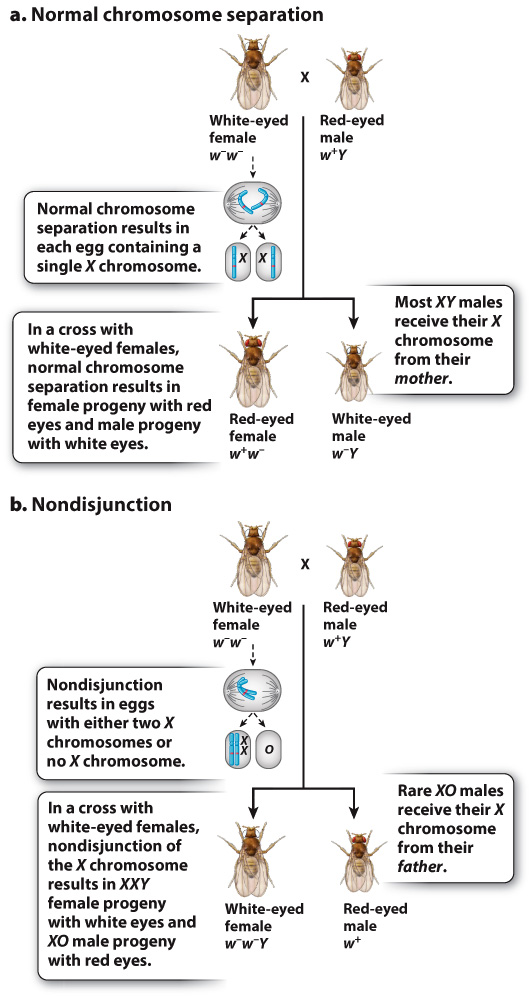X-linkage provided the first experimental evidence that genes are in chromosomes.
Morgan’s original experiments indicated that the white-
In one set of experiments, Bridges crossed mutant white-

But Bridges noted a few rare exceptions among the progeny. He saw that about 1 offspring in 2000 from the cross was “exceptional”—either a female with white eyes or a male with red eyes. The exceptional females were fertile, and the exceptional males were sterile. To explain these exceptional progeny, Bridges proposed the hypothesis diagrammed in Fig. 17.6b: The X chromosomes in a female occasionally fail to separate in anaphase I in meiosis, and both X chromosomes go to the same pole. Recall from Chapter 15 that chromosomes sometimes fail to separate normally in meiosis, a process known as nondisjunction. Nondisjunction of X chromosomes results in eggs containing either two X chromosomes or no X chromosome. Figure 17.6b shows the implications for eye color in the progeny if the hypothesis is correct. The exceptional white-
Bridges’s hypothesis for the exceptional progeny in Fig. 17.6b was bold, as it assumed that Drosophila males could develop in the absence of a Y chromosome (XO embryos yielding sterile males, where “O” indicates absence of a chromosome), and that females could develop in the presence of a Y chromosome (XXY embryos yielding fertile females). The hypothesis was accurate as well as bold. Microscopic examination of the chromosomes in the exceptional fruit flies confirmed that the exceptional white-
Bridges’s demonstration that genes are present in chromosomes was also the first experimental evidence of nondisjunction. Drosophila differ from humans in that the Y chromosome is necessary for male fertility but not for male development. As we will see later in this chapter, a gene in the Y chromosome itself is the trigger for male development in humans and other mammals, and so for these organisms, the Y chromosome is needed both for male development and male fertility. Nondisjunction occasionally takes place in meiosis in humans as well as in fruit flies. When nondisjunction takes place in the human sex chromosomes, it results in chromosomal constitutions such as 47, XXY and 47, XYY males as well as 47, XXX and 45, X females. Nondisjunction of autosomes can also occur, resulting in fetuses that have extra copies or missing copies of entire chromosomes. The consequences of nondisjunction of human chromosomes were examined in Chapter 15.